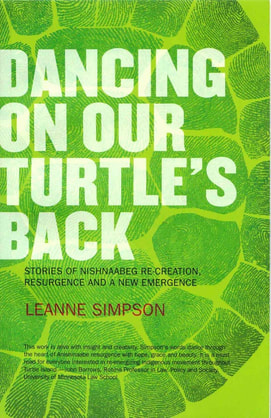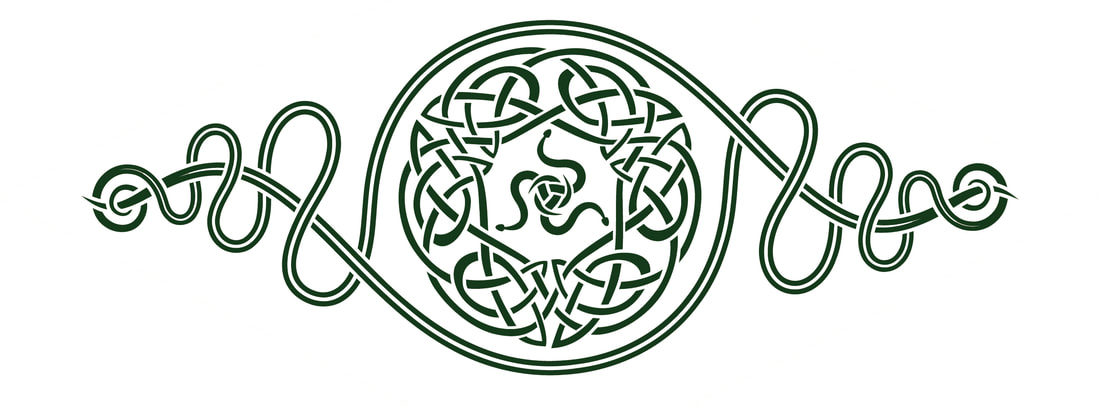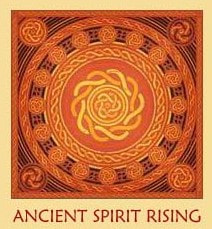REVIEW BY PEGI EYERS
I am a person of Celtic descent, rooted for five generations in the beauty of the Ontario landscape, and my particular soul journey is to recover my own European Indigenous Knowledge (EIK) and reclaim a sacred relationship to Earth Community. As a relative newcomer to Turtle Island, I am well aware of my limitations in any reading or comment on the work of those Indigenous to place, and my bonds to the land will always be preceded by the much deeper attachments of the original First Nations.
As a beautifully-crafted clarion call, Leanne Simpson’s Dancing on Our Turtle’s Back:: Stories of Nishnaabeg Re-Creation, Resurgence, and a New Emergence is specifically directed to the Nishnaabeg Nation and the Mississauga Ojibway, the original inhabitants of the Kawarthas in Southern Ontario. This exceptional book is a blending of wisdom teachings from the Elders, stories that flow from myth and the oral tradition, illuminations of heart-knowledge (Debwewin, or “truth”), studies on the Nishnaabeg language and stages of life, and solid research interspersed with brilliant observation. Dancing on Our Turtle’s Back gets to the core of the Nishnaabeg experience, identifying exactly what the challenges have been, and the path toward transformation and "Mino Bimaadiziwin," the Good Life.
Leanne speaks of “celebrating our resistance, our survival, our continuance, that after everything we are still here.” She says that resurgence is most powerfully found in the recovery of Nishnaabeg intellect and holistic values as embedded in the ancient stories and traditions, and lifeways that promote well-being in government, education and restorative justice. Storytelling and contemporary performance also evoke spaces of resistance, freedom and justice, and have their ultimate value as practices that lift the burden of colonialism and transform reality. She goes on to say that nurturing the next generation by modeling Nishnaabeg ethics, core philosophies and egalitarian leadership styles to the children is of critical importance, and the greatest hope for the emergence to come.
Dancing on Our Turtle’s Back also presents important learning opportunities for all Canadians. The descendants of the Settler Society need to understand the extent of the racist policies of the colonial system, and the horrific genocide, dispossession, forced relocation and assimilation as experienced by First Nations. When we know this truth, we will be obliged to embrace new intercultural competency skills, and as allies, to support decolonization and the emergence of a strong and recovered Nishnaabeg Nation. Leanne Simpson is a guiding light in the movement toward Nishnaabeg empowerment, and among other powerful truths, she tells us that ”our creation story tells us another world is possible, and that we have the tools to vision it and bring it into reality. I can’t think of a more powerful narrative.”
As a beautifully-crafted clarion call, Leanne Simpson’s Dancing on Our Turtle’s Back:: Stories of Nishnaabeg Re-Creation, Resurgence, and a New Emergence is specifically directed to the Nishnaabeg Nation and the Mississauga Ojibway, the original inhabitants of the Kawarthas in Southern Ontario. This exceptional book is a blending of wisdom teachings from the Elders, stories that flow from myth and the oral tradition, illuminations of heart-knowledge (Debwewin, or “truth”), studies on the Nishnaabeg language and stages of life, and solid research interspersed with brilliant observation. Dancing on Our Turtle’s Back gets to the core of the Nishnaabeg experience, identifying exactly what the challenges have been, and the path toward transformation and "Mino Bimaadiziwin," the Good Life.
Leanne speaks of “celebrating our resistance, our survival, our continuance, that after everything we are still here.” She says that resurgence is most powerfully found in the recovery of Nishnaabeg intellect and holistic values as embedded in the ancient stories and traditions, and lifeways that promote well-being in government, education and restorative justice. Storytelling and contemporary performance also evoke spaces of resistance, freedom and justice, and have their ultimate value as practices that lift the burden of colonialism and transform reality. She goes on to say that nurturing the next generation by modeling Nishnaabeg ethics, core philosophies and egalitarian leadership styles to the children is of critical importance, and the greatest hope for the emergence to come.
Dancing on Our Turtle’s Back also presents important learning opportunities for all Canadians. The descendants of the Settler Society need to understand the extent of the racist policies of the colonial system, and the horrific genocide, dispossession, forced relocation and assimilation as experienced by First Nations. When we know this truth, we will be obliged to embrace new intercultural competency skills, and as allies, to support decolonization and the emergence of a strong and recovered Nishnaabeg Nation. Leanne Simpson is a guiding light in the movement toward Nishnaabeg empowerment, and among other powerful truths, she tells us that ”our creation story tells us another world is possible, and that we have the tools to vision it and bring it into reality. I can’t think of a more powerful narrative.”
Excerpts of this review were
published by Arbiter Ring Publishing
and The Bookshelf in Guelph, ON
published by Arbiter Ring Publishing
and The Bookshelf in Guelph, ON
| Pegi Eyers is the author of "Ancient Spirit Rising: Reclaiming Your Roots & Restoring Earth Community," an award-winning book that explores strategies for intercultural competency, uncolonization, recovering an ecocentric worldview, rewilding, creating a sustainable future and reclaiming peaceful co-existence in Earth Community. Available from Stone Circle Press or Amazon. |



